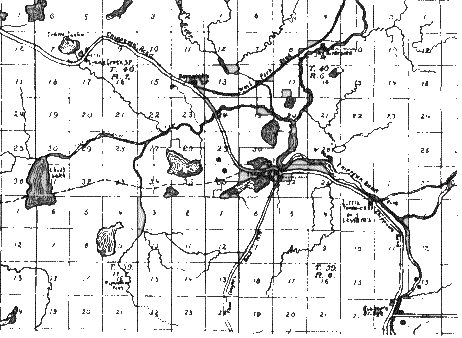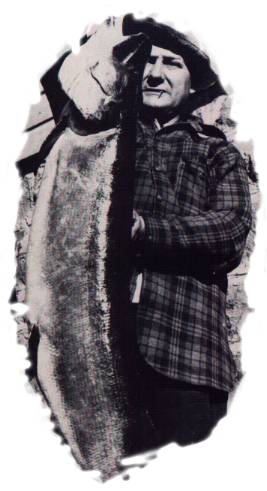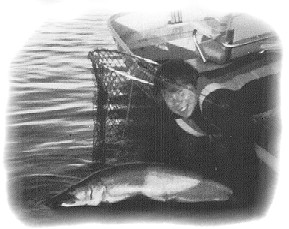 During the first
15 years of its existence, the Chippewa Flowage was known to be more of an action lake
with its trophy-producing potential remaining rather limited until this new and sprawling
reservoir would mature. With its native population continually being expanded by a
consistent influx of numbers of Musky from the West and East Forks of the Chippewa River,
the waters adjacent to these rivers became the flowage's first hotbeds of musky action. By
around 1938, trophy Musky began to show up with more regularity. From then on, specimens
40# and over were known to be caught on occasion.
During the first
15 years of its existence, the Chippewa Flowage was known to be more of an action lake
with its trophy-producing potential remaining rather limited until this new and sprawling
reservoir would mature. With its native population continually being expanded by a
consistent influx of numbers of Musky from the West and East Forks of the Chippewa River,
the waters adjacent to these rivers became the flowage's first hotbeds of musky action. By
around 1938, trophy Musky began to show up with more regularity. From then on, specimens
40# and over were known to be caught on occasion.
 To date, since the flowage was first created 75 years
ago, some 60 Musky over 40# have been caught-at least 8 of which were in the 45 pound
class or better. While this number still represents a rather impressive tally, it's important to note that originally more big fish were believed
to have been caught out of the flowage... but, as it turns out, a number of them now prove
to have been exaggerated. Besides the current world record Musky which was taken out of
the flowage in 1949, there have been only two other 50 pound plus Musky documented to have
come out of the Chippewa Flowage. (Note: a 51 pounder did come from Chief Lake in 1946,
before the flowage was formed) There were tales of a couple of other 50 pounders
that were taken from the flowage, but now there are strong indications that they too were
exaggerated in size.
To date, since the flowage was first created 75 years
ago, some 60 Musky over 40# have been caught-at least 8 of which were in the 45 pound
class or better. While this number still represents a rather impressive tally, it's important to note that originally more big fish were believed
to have been caught out of the flowage... but, as it turns out, a number of them now prove
to have been exaggerated. Besides the current world record Musky which was taken out of
the flowage in 1949, there have been only two other 50 pound plus Musky documented to have
come out of the Chippewa Flowage. (Note: a 51 pounder did come from Chief Lake in 1946,
before the flowage was formed) There were tales of a couple of other 50 pounders
that were taken from the flowage, but now there are strong indications that they too were
exaggerated in size.
A substantial effort to overstate the sizes of a number of the flowage's big Musky catches for publicity purposes during the '40s and '50s has seriously distorted the perceptions of many who are now trying to assess the fishery and look back to compare today's realities to yesterday's exaggerations. Keep in mind that today the flowage is still producing decent numbers of mid-30 pound fish, but a number of these very same fish would have been counted as being over 40 pounds years ago because of the tendency to exaggerate.
 Following
the world-record Musky catch of 69 pounds 11 oz. in 1949, Musky fishing pressure rose
substantially on the flowage, reaching its peak levels from the late 1970s through the mid
1980s. Prior to the late 1970s, most Musky were kept and, although the flowage still was
offering excellent Musky fishing by most standards, during this period the flowage had
probably been fished down to its lowest level. Beginning at this time, peer pressure
amongst the Musky fraternity began to perpetuate a mindset of catch and release and
immediate improvements in the flowage's Musky fishery were observed. The catch and
release program is now stronger than ever and, today, comprehensive catch records which
are kept by the flowage's resorts put release rates at over 95%. This has resulted in a
greatly improved Musky fishery on the Chippewa Flowage during the past decade…with
more Musky and higher average sizes of Musky being caught today than during any other
period in recorded history on the flowage. However, 40 pound class Musky have not been
showing up quite as often as they used to.
Following
the world-record Musky catch of 69 pounds 11 oz. in 1949, Musky fishing pressure rose
substantially on the flowage, reaching its peak levels from the late 1970s through the mid
1980s. Prior to the late 1970s, most Musky were kept and, although the flowage still was
offering excellent Musky fishing by most standards, during this period the flowage had
probably been fished down to its lowest level. Beginning at this time, peer pressure
amongst the Musky fraternity began to perpetuate a mindset of catch and release and
immediate improvements in the flowage's Musky fishery were observed. The catch and
release program is now stronger than ever and, today, comprehensive catch records which
are kept by the flowage's resorts put release rates at over 95%. This has resulted in a
greatly improved Musky fishery on the Chippewa Flowage during the past decade…with
more Musky and higher average sizes of Musky being caught today than during any other
period in recorded history on the flowage. However, 40 pound class Musky have not been
showing up quite as often as they used to.
 While fishermen are now
armed with the latest technology and high-powered boats which enable them to cover more
water more efficiently, this very same so called "advantage" is also likely to
be a disadvantage…as these high-powered boats are likely to have spooked many of the
biggest trophy Musky (which traditionally have always been caught on the shallow mid-lake
bars) out of the shallows and into areas where they are now much less accessible to
fishermen. This may indeed be a significant contributing factor as to why 40 pound plus
Musky seem to be a bit more elusive these days.
While fishermen are now
armed with the latest technology and high-powered boats which enable them to cover more
water more efficiently, this very same so called "advantage" is also likely to
be a disadvantage…as these high-powered boats are likely to have spooked many of the
biggest trophy Musky (which traditionally have always been caught on the shallow mid-lake
bars) out of the shallows and into areas where they are now much less accessible to
fishermen. This may indeed be a significant contributing factor as to why 40 pound plus
Musky seem to be a bit more elusive these days.
Or perhaps the population of the flowage has reached a saturation point and, because there are today so many more big Musky (15 to 35 pounds) teeming in its waters, either the competition for food makes it a bit more difficult to grow fish over 40pound…or simply the much greater number of big Musky proportionate to the flowage's entire population has merely lowered our odds of connecting with one of the comparatively rarer 40 pounders. Or, possibly, could it be that there are two different species of Musky, a river species and a lake species, and if so, could the river species which is theorized to be a genetically superior fish and capable of attaining larger proportions perhaps be dwindling in numbers?
The Study
In a sport such as Musky fishing, which can be as humbling as it is even maddening at times, a host of theories have been formulated regarding this most unpredictable fish. And one of the more thoroughly researched theories which has been arrived at during recent years is the concept of there being two distinct and different species of Musky: a river species which is believed to have the genes to grow larger than normal and the lake species which "max out" at smaller sizes. The subject of a doctoral thesis by Canadian biologist Bernard Lebeau, this two-species concept was, originally, bolstered by the false belief that many of yesteryear's reportedly huge Musky catches are not being matched today…but it has more recently come out that most of these reported huge Musky catches never existed in the first place.
Notwithstanding, the two-species concept certainly deserves looking into. Although it is backed up by what some say is very convincing evidence, other biologists caution that "the school is still out on this hypothesis." This leads us into the primary motivation behind one of the most comprehensive Musky fisheries studies ever done in North America: a three-year radio telemetry study which began in May, 1998 on the Chippewa Flowage.
Beginning with a monetary commitment from the LCO Tribal Governing Board, the following nine entities have joined forces to make this study a reality: the LCO Community Development Corporation; Wisconsin DNR; LCO Conservation Department; U.S. Fish & Wildlife Service; LCO Fish Hatchery; Great Lakes Indian Fish & Wildlife Commission; Bureau of Indian Affairs; University of Wisconsin-Extension; and University of Wisconsin-Superior. In addition to the LCO tribe committing facilities and personnel to the project, the DNR, U.S. Fish & Wildlife Service, and the University of Wisconsin-Extension have all donated equipment or committed services to this study.
The LCO Community Development Corporation's Executive Director, Scott Allen, will be heading up the project, and Chuck Martin, Dan Tyrolt, and George Morrow of the LCO Conservation Department have committed themselves to the study with their goal of preserving and restoring Musky habitat within the flowage.
The U.S. Fish & Wildlife Service has contributed telemetry and tracking equipment to be used, with their own Frank Stone assisting in data gathering and its analysis. Beginning with 1998’s Musky spawning activities on the Chippewa Flowage, Musky were captured in specialized nets furnished by the DNR and tagged with radio telemetry transmitter tags…so that their spawning movements can be tracked. And, once into the open Musky season, local Musky anglers Larry Ramsell, Ty Sennett, Scott Allen and myself, will be tagging a number of their own Musky catches with these transmitter tags as well.
Measuring about one inch long, 1½ inch wide, and ¼ inch deep, these antennaed tags will be attached to the Musky's dorsal fin, and will not be implanted intrusively into the Musky's body like other transmitter devices of past studies. It is the plan to tag 30 to 40 Musky, each season, for the next three seasons-totaling 90 to 120 tagged Musky in the flowage by the end of the 2000 Musky season. And at around $350 per tag, one can begin to see the monetary commitment which is involved.
With the overall objective of this study being to enhance and preserve the Chippewa Flowage's trophy Musky fishery, this project's goals are to: identify and preserve spawning habitat; determine if, indeed, two species of muskies exist in the flowage and, if so, isolate the genetically superior Musky and use them for breeding and stocking purposes; embark on a year-round tracking study of the radio-tagged Musky in the flowage; provide a complimentary data base contribution for the DNR's comprehensive 1999 Chippewa Flowage creel census; observe the survival rates of Musky which have been caught and released; and, in the long run, set the stage for enhanced economic development opportunities for both tribal and non-tribal citizens.
Also being researched as a part of this study is the data compiled by area guide, Wayne Gutsch, during which some 1,634 Musky were either caught, tagged, and released or were later recaptured from 1979 through 1986. This data had been forwarded to the DNR's Fisheries Manager of Hayward, Frank Pratt, who, along with Dave Berard Sawyer County Agent for the University of Wisconsin-Extension, will analyze the data. Their findings will be used for educational purposes by Berard and Dr. William Swenson the University of Wisconsin-Superior, who will design an educational curriculum for project participants and the public.
During the course of the tag and release program that Wayne Gutsch was in charge of from 1979 to 1986, it was observed that the average size of the Musky caught dramatically increased by the end of the eight-year study. From 1979 to 1986, the percentage of Musky caught over 40" went from only 2.6% in 1979 up to 15.3% in 1986. The number of Musky caught also increased sharply during those years. Average annual growth rates of those fish tagged and then recaptured was over 2½ inches, with some Musky growing as much as 4 or 5 inches in a year. While Musky tagged in the flowage were observed to migrate, they tended to remain within larger "home areas" of the flowage which were "corralled" by various natural boundaries of the lake.
Are There Still Record Class Musky Out There?
 While these
critters always have been and always will be very rare, record-class Musky have been
sighted by reliable sources every so often on the flowage. Keep in mind that had it been
for just a minute twist of fate--Louie Spray could have lost his 1949 record fish and luck
could have smiled upon someone else in the flowage during recent years, granting them a
record-caliber Musky. Of course, such a singular occurrence would have greatly changed the
way we are looking now at our fishery.
While these
critters always have been and always will be very rare, record-class Musky have been
sighted by reliable sources every so often on the flowage. Keep in mind that had it been
for just a minute twist of fate--Louie Spray could have lost his 1949 record fish and luck
could have smiled upon someone else in the flowage during recent years, granting them a
record-caliber Musky. Of course, such a singular occurrence would have greatly changed the
way we are looking now at our fishery.
During the past decade on the flowage, I personally had a Musky near the 50 pound class or bigger surface right next to my boat; guide Ray Blank had a huge Musky up three different times which he was convinced was in the record class; and I personally witnessed Scott Allen lose a huge fish which I believe was in the 50 pound range, after he lost it by the boat following an unusually lengthy battle.
During the decade before, a 50 pound class fish called "the Alligator" busted many an angler's tackle; a much larger fish in the world-record class terrorized a number of Musky men on the flowage (including myself); and I personally saw-and had on and lost-the largest Musky I had ever seen.. a 60 inch class fish!
And, during the decade before that, a five foot Musky was dealt with many times, but never caught, in the central part of the flowage; one called "Freight Train," which was said to have been a world-record Musky, was regularly sighted on Turkey's Bar; and Poppel Island was also said to have shown a Musky in that size class on a number of occasions.
And so the tales continue down through the ages…the Chippewa Flowage has a track record of showing these phantoms of the deep from time to time. The potential has always been there on the magnificent flowage and maybe this study will allow us to unlock a few more secrets that will help us up the odds even a bit more of crossing paths with one of these beasts.